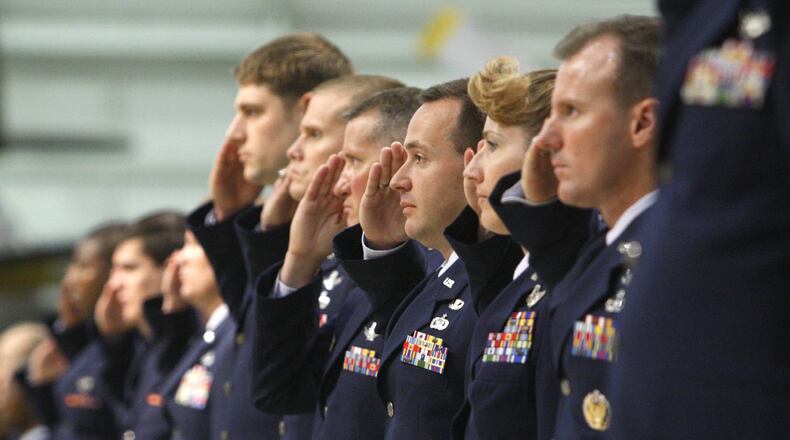The increase in employment is the result of the base having better “local hiring authority” from the Air Force to fill new positions and vacancies that remained from a hiring freeze, said Col. Tom Sherman, 88th Air Base Wing and installation commander.
» RELATED: Demand for veteran burials could put strain on national cemeteries
“Our work here makes the Air Force stronger, faster and smarter – to keep a dominating edge over our adversaries,” Sherman said. “We need talented new professionals working here to execute that important mission.”
This year marks just the 10th time Wright-Patt has employed more than 30,000 in 101 years, base data shows. At it’s peak during World War II, the base employed around 46,500 military and civilian employees in 1942.
Around 10,000 more people now work at the base than in 2003, which Rep. Mike Turner, R-Dayton, said was the first year he was elected to Congress.
“We have worked as a region, as a community executing a strategic plan for the synergies and the growth that has occurred here,” Turner said during a meeting of the National Aviation Heritage Alliance this week. “What’s important is that it’s all innovation. We’re not a base that has a lot of planes. We’re a base that has a lot of scientists, engineers, people who are working diligently to advance knowledge and advance capabilities and what we might be able to do for the future.”
The growth can be attributed to additional military funding that is being directed primarily to research and development, said Loren Thompson, senior defense analyst with the Virginia-based Lexington Institute. In all, the most recent federal budget bill included around $718 million in defense funding.
More research money is a good thing for Wright-Patt, Thompson said, since it’s home to the Air Force Research Laboratory.
“You can thank the Trump administration for the increase in employment,” Thompson said. “In 2018, it increased the defense budget by a number bigger than Germany’s entire defense budget.”
Aside from AFRL, several components of Wright-Patt are leading to an upswing in employment. Last year it was announced that an F-35 fighter jet sustainment program will move to the base while the National Air and Space Intelligence Center at Wright-Patt has also added several employees in recent years.
» RELATED: F-35 program won’t be fully operational at Wright-Patt until 2022
The F-35 program could bring at least 400 jobs to the base, Turner along with U.S. Senators Rob Portman, R-Ohio, and Sherrod Brown, D-Ohio, announced last year. The program will become fully operational at Wright-Patt by the spring of 2022, an Air Force Materiel Command spokesman told the Dayton Daily News.
As national decision makers and others have demanded more intelligence, NASIC’s workforce increased by about 1,500 employees, or 100 a year between 2000 to 2015, according to the agency.
The intelligence agency is also in the midst of a massive $182-million building expansion project that is one of the largest in Wright-Patt’s history. The building will bring employees in six different locations into one facility and will add 900 seats to house intelligence analysts and engineers and add labs.
While the milestone seals Wright-Patt’s spot as the state’s largest single-site employer, it also means the base continues to be one of the Air Force’s biggest installations, said Maurice “Mo” McDonald, executive vice president of aerospace and defense for the Dayton Development Coalition.
“We are extremely excited with the job growth that’s happened at Wright Patt,” McDonald said. “It’s a testament to the work that they do there.”
Estimates show that the base could top more than 33,000 employees in the next few years, Turner said. But, a base spokesman said he could not confirm that projection.
Regardless, Thompson said there are no “negatives for Wright-Patt in this environment.” That’s an indication, he and others said, that the base will continue to grow.
“I think it highlights how important how important Wright-Patterson Air Force Base and Springfield Air National Guard Base are to the region,” said Rep. Warren Davidson, R- Troy. “We’re excited that the Air Force continues to grow here in an area that has been so instrumental to the history of aviation and aerospace.”
FIVE FAST READS
• Would governor’s 17-point plan stopped Sunday’s gun violence?
• School of Aerospace Medicine at Wright-Patt gets new leader
• Gov. DeWine: ‘Changes certainly have to be made at Wright State’
• State proposal could lower college tuition for active duty military
• Wright State increases tuition, fees by maximum allowed under Ohio law
By the numebers
The five highest years of employment at Wright-Patt.
1942: 46,500 employees.
1943: 45,747 employees.
1944: 45,475 employees.
1951: 34,684 employees.
1963: 31,458 employees.
About the Author
